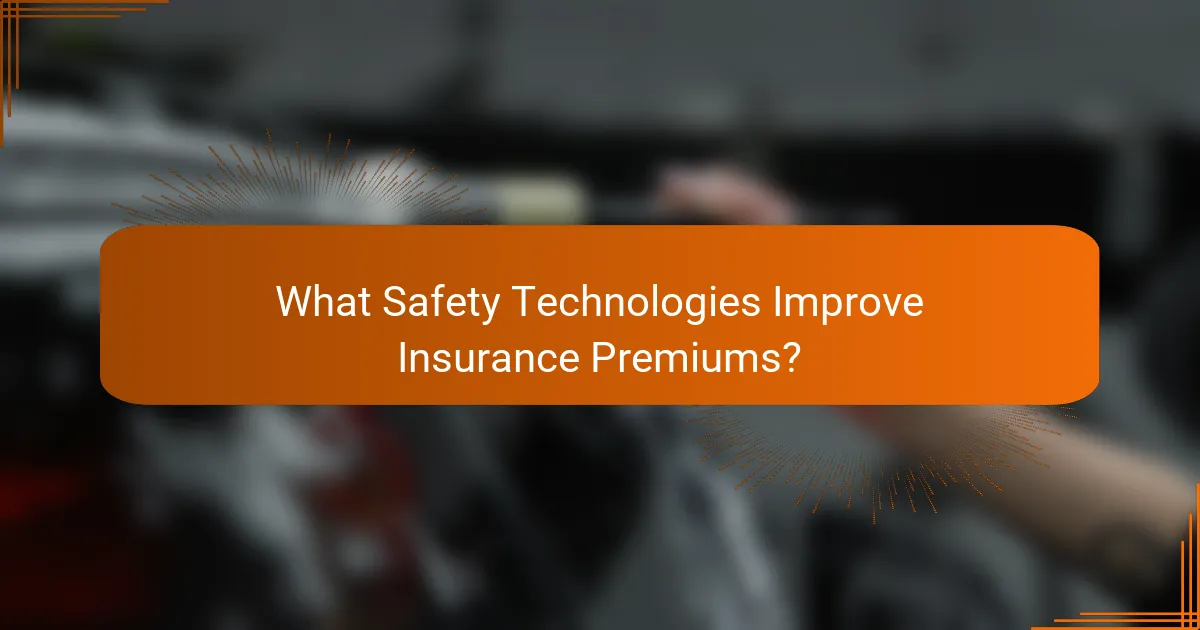Safety tech enhancements play a crucial role in increasing vehicle resale value by attracting buyers with desirable features such as advanced driver-assistance systems. Additionally, these technologies can lead to lower insurance premiums by minimizing accident risks, while also improving the overall driving experience by providing greater control and comfort on the road.

How Do Safety Tech Enhancements Affect Vehicle Resale Value?
Safety tech enhancements significantly boost vehicle resale value by making cars more appealing to buyers. Features like advanced driver-assistance systems (ADAS) and high safety ratings can lead to higher demand and better pricing in the used car market.
Increased resale value with advanced safety features
Vehicles equipped with advanced safety features tend to have a higher resale value compared to those without. Buyers are increasingly prioritizing safety technology, which can include features like automatic emergency braking, lane-keeping assist, and adaptive cruise control. As a result, cars with these enhancements can command prices that are tens of percent higher than similar models lacking such features.
Impact of safety ratings on market demand
Safety ratings play a crucial role in influencing market demand for used vehicles. Cars that receive high ratings from organizations like the National Highway Traffic Safety Administration (NHTSA) or the Insurance Institute for Highway Safety (IIHS) are more attractive to potential buyers. A strong safety rating can lead to quicker sales and higher offers, as consumers often associate these ratings with reliability and lower insurance costs.
Examples of vehicles with high resale value
Several vehicles are known for their high resale value due to their safety features and ratings. For instance, the Subaru Outback and Honda CR-V consistently receive top safety marks and maintain strong resale prices. Additionally, luxury brands like Volvo and Audi often feature advanced safety tech, making their models desirable in the second-hand market.

What Safety Technologies Improve Insurance Premiums?
Safety technologies can significantly lower insurance premiums by reducing the risk of accidents. Features like collision avoidance systems and telematics not only enhance vehicle safety but also make drivers eligible for discounts from insurers.
Discounts for vehicles with collision avoidance systems
Vehicles equipped with collision avoidance systems often qualify for substantial insurance discounts. These systems use sensors and cameras to detect potential collisions and can automatically apply brakes or steer to avoid accidents.
Insurance companies recognize that these technologies lower the likelihood of claims, leading to discounts that can range from 10% to 30% off premiums. When shopping for insurance, inquire specifically about discounts for vehicles with these safety features.
Impact of telematics on insurance rates
Telematics devices monitor driving behavior, including speed, braking patterns, and acceleration. Insurers use this data to assess risk and can adjust premiums based on individual driving habits.
Safe driving behaviors can lead to lower premiums, sometimes by as much as 15% to 25%. However, risky driving could result in higher rates, so it’s essential to understand how your driving style may impact your insurance costs.
Examples of insurance companies offering safety tech discounts
Many insurance companies provide discounts for vehicles with advanced safety technologies. For instance, Progressive and State Farm offer savings for drivers using telematics devices or those with collision avoidance features.
Additionally, Allstate has a program that rewards safe driving through its Drivewise app, which tracks driving habits and offers cash back for safe behavior. Always compare different insurers to find the best discounts available for your vehicle’s safety technologies.

How Do Safety Features Enhance the Driving Experience?
Safety features significantly enhance the driving experience by providing drivers with greater control, confidence, and comfort. These technologies not only help prevent accidents but also make driving more enjoyable and less stressful.
Improved driver confidence with advanced safety systems
Advanced safety systems like adaptive cruise control, lane-keeping assist, and automatic emergency braking boost driver confidence by reducing the likelihood of collisions. These features actively monitor the vehicle’s surroundings and can intervene when necessary, allowing drivers to feel more secure on the road.
Moreover, systems that provide real-time feedback on driving habits can help drivers improve their skills. By understanding how their driving affects safety, individuals can make informed adjustments to their behavior, leading to a more confident driving experience.
Enhanced comfort through automated driving aids
Automated driving aids, such as parking assist and traffic jam assist, enhance comfort by simplifying complex driving tasks. These technologies can take over steering, acceleration, and braking in certain conditions, allowing drivers to relax during stressful situations like heavy traffic or tight parking scenarios.
Additionally, features like blind-spot monitoring and rear cross-traffic alerts provide peace of mind by helping drivers avoid potential hazards. This added layer of comfort can transform the driving experience, making it less taxing and more enjoyable.
Real-world examples of vehicles with superior driving experiences
Several vehicles are renowned for their advanced safety features and enhanced driving experiences. For instance, the Tesla Model 3 offers an extensive suite of automated driving aids, including Autopilot, which allows for semi-autonomous driving in various conditions.
Another example is the Volvo XC90, which includes a comprehensive safety system that features collision avoidance technology and a robust suite of driver assistance features. These vehicles exemplify how integrating safety technology can lead to a more enjoyable and secure driving experience.

What Are the Key Criteria for Evaluating Safety Tech?
Key criteria for evaluating safety technology in vehicles include safety ratings, certifications, and the cost-benefit analysis of investments in these technologies. Understanding these factors helps consumers make informed decisions about vehicle purchases and insurance implications.
Importance of safety ratings and certifications
Safety ratings and certifications are crucial indicators of a vehicle’s crashworthiness and overall safety performance. Organizations like the National Highway Traffic Safety Administration (NHTSA) and the Insurance Institute for Highway Safety (IIHS) provide ratings that reflect how well vehicles perform in crash tests.
When considering a vehicle, look for models with high safety ratings, as these can enhance resale value and potentially lower insurance premiums. For example, a vehicle with a five-star NHTSA rating may attract buyers willing to pay more due to its proven safety record.
Cost-benefit analysis of safety tech investments
Investing in advanced safety technologies, such as automatic emergency braking or lane-keeping assist, can lead to significant long-term savings. While these features may increase the initial purchase price, they often reduce the likelihood of accidents, which can lower insurance premiums and repair costs.
Consider the potential savings against the upfront costs. For instance, if a safety package adds $1,500 to the vehicle price but reduces insurance premiums by $200 annually, the investment may pay off within a few years. Evaluate your driving habits and local accident statistics to determine the most beneficial safety tech for your needs.

How Does Safety Tech Influence Consumer Buying Decisions?
Safety technology significantly impacts consumer buying decisions by enhancing perceived vehicle reliability and reducing insurance costs. Features like automatic emergency braking and lane-keeping assist not only improve safety but also appeal to buyers looking for value in resale and insurance premiums.
Consumer preferences for vehicles with advanced safety features
Many consumers prioritize advanced safety features when selecting a vehicle, often viewing them as essential rather than optional. Features such as adaptive cruise control, blind-spot monitoring, and collision avoidance systems are increasingly seen as indicators of a vehicle’s overall quality and reliability.
Research indicates that buyers are willing to pay a premium for cars equipped with these technologies, often expecting a return on investment through higher resale values and lower insurance premiums. This trend is particularly strong among families and safety-conscious individuals.
Market trends towards safety-focused vehicle purchases
The automotive market is shifting towards safety-focused purchases, driven by both consumer demand and regulatory pressures. Manufacturers are increasingly integrating advanced safety technologies to meet safety standards and attract buyers who prioritize these features.
As a result, vehicles equipped with comprehensive safety tech are becoming more prevalent, with many new models featuring these systems as standard. This trend is expected to continue, with forecasts suggesting that a significant portion of new vehicles sold will include advanced safety features within the next few years.

What Are the Emerging Trends in Vehicle Safety Technology?
Emerging trends in vehicle safety technology focus on enhancing safety features, improving the driving experience, and potentially influencing resale values and insurance premiums. Innovations such as autonomous driving and AI integration are at the forefront of these developments, reshaping how vehicles operate and how drivers interact with them.
Growth of autonomous driving technologies
The growth of autonomous driving technologies is revolutionizing vehicle safety by reducing human error, which is a leading cause of accidents. Features like adaptive cruise control, lane-keeping assistance, and automatic emergency braking are becoming standard in many new vehicles, enhancing overall safety.
As these technologies advance, they are expected to significantly lower accident rates, which could lead to a decrease in insurance premiums over time. However, the transition to fully autonomous vehicles will require careful regulation and public acceptance to ensure safety and reliability.
Integration of AI in safety systems
AI integration in safety systems is enhancing vehicle responsiveness and decision-making capabilities. Advanced driver-assistance systems (ADAS) utilize machine learning algorithms to analyze real-time data from sensors, improving features like collision avoidance and pedestrian detection.
This technology not only increases safety but also contributes to a more enjoyable driving experience. As AI continues to evolve, vehicles will become more adept at predicting and reacting to potential hazards, further reducing the likelihood of accidents.
Future implications for vehicle resale and insurance
The advancements in vehicle safety technology are likely to have significant implications for resale values and insurance costs. Vehicles equipped with the latest safety features may retain higher resale values due to increased demand for safer options among consumers.
Insurance companies may also adjust premiums based on the safety technology present in vehicles. Cars with advanced safety systems could qualify for lower rates, incentivizing buyers to invest in newer models with enhanced safety features. This shift emphasizes the importance of staying informed about safety tech when purchasing a vehicle.
